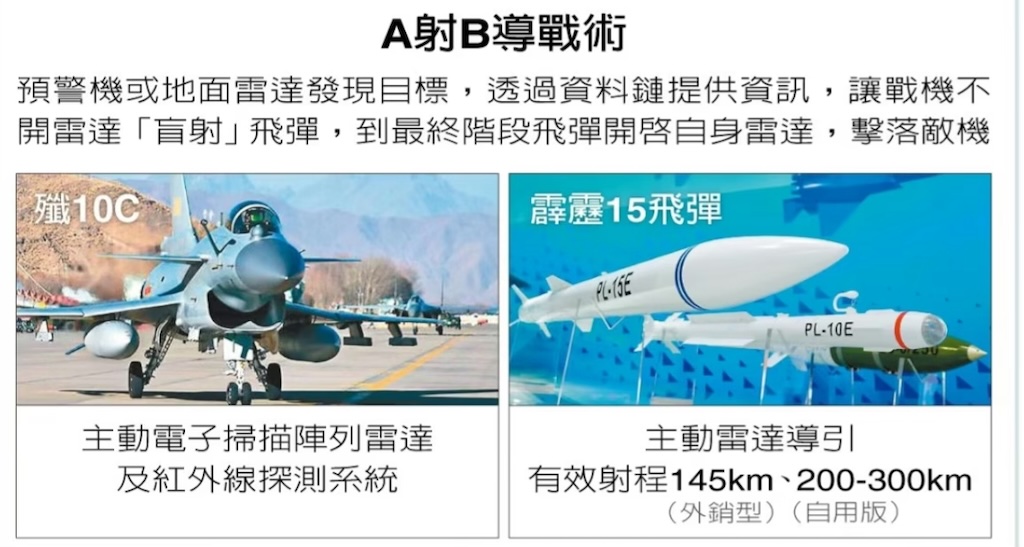
當你提到「A射B導戰術」,這是一個在現代導彈系統中常見的戰術概念,屬於協同作戰火力指引的一種策略。這裡我們來深入解析這個術語的意涵、應用場景與技術挑戰。
⸻
一、「A射B導」是什麼?
「A射B導」全名為「A平台發射,B平台導引」,是指一個作戰平台(如戰機、艦艇或地面發射單元)負責發射飛彈,而另一個不同的平台負責導引飛彈飛行至目標。
這樣的戰術打破了傳統上單一平台從發射到命中的一體化流程,提升了作戰的彈性與跨平台整合能力。
⸻
二、具體流程(以實際戰場為例)
假設:
•A 是一架隱形戰機(如 F-35),靠近敵區,潛伏偵查。
•B 是遠距離雷達機(如 E-2D 或陸基雷達)。
•C 是目標(敵方戰艦或地面設施)。
作戰流程如下:
1.偵查與標定目標:
•B 平台(例如雷達機)偵測到 C 目標,並持續追蹤其位置。
2.火控與發射:
•A 平台收到目標數據後,發射飛彈(如空對艦導彈或巡弋飛彈)。
•此時飛彈可能尚未鎖定目標,而是飛向大致方向。
3.中段導引:
•B 平台利用其高功率雷達,將飛彈中段飛行的路徑修正,確保其逼近目標。
•導引方式可能包括數據鏈(Data Link)傳輸目標更新資訊給飛彈。
4.末段導引與命中:
•當飛彈接近目標時,開啟自帶的雷達或紅外導引頭,完成最後鎖定並命中。
⸻
三、戰術優勢
1.提升平台存活率:
•發射平台(A)可以在不暴露目標資訊的情況下快速發射,然後轉入隱蔽。
•導引平台(B)可在遠距或安全位置操作,降低戰損風險。
2.增強跨域協同作戰能力:
•各種平台可以互補,如海軍艦艇為空軍導引飛彈,或無人機協助有人機瞄準。
3.射程突破與超視距打擊:
•目標不需在射手平台的雷達範圍內,只需導引平台掌握,戰術範圍大幅擴張。
⸻
四、技術挑戰與限制
•數據鏈延遲與抗干擾能力:飛彈需與導引平台穩定連線,否則會喪失修正能力。
•平台間協同標準(如Link-16、Link-22):需具備高度互通的通信協議與識別邏輯。
•敵方電戰與反導作為:敵人可干擾導引波束或導引平台的雷達信號,造成導引失效。
⸻
五、實戰應用案例
•美軍「聯合打擊武器網路」(JADC2, Joint All-Domain Command and Control)就是「A射B導」戰術的極致應用,強調各軍種平台間的即時數據融合。
•**中共反艦彈道飛彈(如東風-21D)**可能也具備「A射B導」特性,由地面單元發射,靠海上或空中平台追蹤航母導引。
⸻
結語
「A射B導」是新世代網絡化戰爭的重要支柱,讓武器的精準打擊能力不再侷限於單一平台。它是一種「分工合作式的致命精準」,將作戰視野從「點對點」推向「系統對系統」的維度。
未來,這種戰術模式將隨著無人機群、AI導引與量子通信技術的融合,進一步進化成全自主、多平台聯合攻擊的智能戰術生態。
1. What is “A-shoots, B-guides”?
“A-shoots, B-guides” (shortened as A-shoot-B-guide) refers to a coordinated combat tactic where Platform A launches a missile, but Platform B handles its guidance toward the target.
This breaks the traditional single-platform model—where the same unit handles both launch and guidance—and instead distributes responsibilities across multiple systems, enhancing operational flexibility and survivability.
⸻
2. How it works (with a battlefield example)
Imagine the following:
•A is a stealth fighter (e.g., F-35), flying close to enemy territory.
•B is an airborne radar aircraft (e.g., E-2D) or a ground-based radar system.
•C is the target, such as an enemy ship.
Step-by-step operation:
1.Target Detection:
•Platform B detects Target C and continuously tracks it with radar.
2.Missile Launch:
•Platform A receives the targeting data and launches a missile.
•At launch, the missile may not have direct lock-on; it is directed toward the general area.
3.Mid-course Guidance:
•Platform B transmits updated guidance data to the missile during its mid-flight phase, adjusting its course toward the target.
•This data is sent via secure data link systems.
4.Terminal Homing:
•As the missile nears the target, it activates its own seeker (e.g., radar or infrared) to lock on and strike with precision.
⸻
3. Strategic Advantages
•Increased Platform Survivability:
•The launching platform (A) can fire quickly and retreat without exposing itself to enemy sensors.
•The guiding platform (B) operates from a safe distance.
•Cross-Domain Combat Capability:
•Enables joint coordination across air, land, and sea (e.g., a warship guides a missile launched by an aircraft).
•Extended Engagement Range:
•The target does not need to be within the launch platform’s sensor range—as long as Platform B can track it, the missile can hit it from far beyond visual range.
⸻
4. Technical Challenges
•Data Link Stability:
•Real-time updates must be secure and resilient to jamming or interference.
•Interoperability Standards:
•Platforms must use compatible protocols (e.g., Link-16 or Link-22) for seamless communication.
•Enemy Countermeasures:
•Electronic warfare or radar deception could disrupt guidance, causing the missile to lose lock.
⸻
5. Real-World Applications
•U.S. JADC2 (Joint All-Domain Command and Control) is built on this concept, promoting real-time data fusion across all services and platforms.
•China’s DF-21D anti-ship ballistic missile may also follow this approach: launched from land, but guided by other platforms (like satellites or UAVs) to strike moving naval targets.
⸻
Conclusion
“A-shoots, B-guides” represents a leap into network-centric warfare, where precision firepower is distributed, coordinated, and intelligent. This shifts combat from isolated platform strikes to system-vs-system engagements, where integration is the key to dominance.
With future enhancements—like drone swarms, AI-based targeting, and quantum communication—this tactic is evolving into a smart, cooperative web of lethal precision.

新聞辭典/協同接戰關鍵能力
所謂「A射B導」的協同接戰能力(CEC)兩大關鍵:一是各載台之間,能以資料鏈大量交換即時訊息,二是搜索雷達提供的目標位置足夠精確,可讓飛彈飛到距離目標很近,才開啟射控雷達鎖定,讓敵方缺乏足夠時間反應。目前國軍只有紀德級驅逐艦能和美軍神盾艦連線,發射標準二型飛彈攻擊敵機。
國軍的E─2K預警機在美軍具備一定CEC能力,但美方售台的E─2K,並無CEC介面。
E─2D與神盾艦一樣使用相位陣列雷達,能提供射控等級的目標資訊,使CEC能力大增。美軍為強化遠距獵殺,也推出長程空對空飛彈,海軍剛接收標六飛彈的空射版AIM-174,空軍的AIM-260尚在研發中。戰鬥機只需接收預警機提供資訊,就可對自身視界外的目標發射飛彈。
2025年5月10日, Did China’s J-10C just shoot down India’s Rafale fighter jet in a historic air clash over South Asia? In this episode of GVS Deep Dive, Najma Minhas breaks down the emerging reports of Pakistan’s successful air defense using Chinese-made J-10C jets and PL-15 missiles—potentially the first real combat loss for France’s high-end Rafale. This isn’t just about a dogfight. It’s a pivotal moment for global military power, China’s defense exports, and the future of Western arms dominance.
We explore:
- What happened in the Pakistan–India air battle
- How the J-10C performed vs the Rafale and MiG-29
- Why the PL-15 missile matters for future wars
- What this means for China’s growing role in global arms sales
- Is the West losing its edge in military innovation?
Watch till the end for what this could mean for future defense deals, from Egypt to ASEAN—and why China’s model may now be setting the rules of the game.
Do give your comments below. Subscribe and Share our video.
Najma tweets @MinhasNajma
Najma Minhas is Managing Editor, Global Village Space. She has worked with National Economic Research Associates (NERA) in New York, Lehman Brothers in London and Standard Chartered Bank in Pakistan. Before launching GVS, she worked as a consultant with World Bank, and USAID. Najma studied Economics at London School of Economics and International Relations at Columbia University, NewYork. She tweets at @MinhasNajma.
ChatGPT gives a comprehensive summary:
引言與背景(0:00–1:10)
影片以戲劇性的音樂開場,報導中國殲-10C戰機成功擊落法國製印度陣風(Rafale)戰機的消息。
這被形容為軍事技術權力轉移的關鍵時刻,暗示中國的軍事科技可能已趕上西方,但成本卻大幅降低。
空戰事件與經濟衝擊(1:10–2:25)
印度發動「Syndur行動」攻擊巴基斯坦後,兩國空中爆發激烈交戰。
巴基斯坦空軍宣稱擊落5架印度戰機,其中包括2架由中國殲-10C發射PL-15飛彈擊落的陣風。
事件導致印度損失超過10億美元,同時中國相關軍工企業股價飆升40%。
殲-10C首次空對空擊落紀錄(2:25–3:17)
巴基斯坦外長公開表示是中國殲-10C擊落3架陣風戰機,這是殲-10C首次實戰空對空擊落紀錄。
國際軍事專家密切關注此事件,並比較PL-15飛彈與歐洲Meteor飛彈的性能差異。
戰果爭議與戰機比較(3:17–4:05)
印度尚未證實戰機被擊落,但法國及美國情報來源表示已確認此事。
殲-10C屬於4.5代戰機,略遜於中國自製第五代J-20與J-35;陣風則是目前印度空軍最先進的多用途戰機之一。
PL-15飛彈技術解析(4:05–6:24)
PL-15飛彈屬於超視距(BVR)空對空飛彈,出口版本射程約145公里,國內版可達300公里。
具備雙脈衝馬達與AESA雷達導引,速度可超過五馬赫(高超音速),精準度極高。
中印武器來源對比(6:24–7:18)
巴基斯坦約81%的軍事裝備來自中國;
相較之下,印度自2006年起逐步減少俄羅斯軍購,轉向法國、以色列和美國。
法印陣風合作與軍購(7:18–8:37)
印度自2016至2022年間花費87億美元購買36架陣風戰機。
最近更簽署一筆76億美元的追加購買26架海軍版陣風的新合約,此交易可能因本次擊落事件受影響。
中國軍事投資崛起(8:37–10:32)
自2000年至2023年,中國國防預算成長六倍,達2240億美元。
重點投資領域包括:匿蹤飛機、高超音速武器、無人機、網路與太空戰等。
高超音速軍備競賽(10:32–11:52)
中國的DF-17高超音速滑翔飛行器已部署,俄羅斯亦有「前鋒」系統;
美國則剛重啟其高超音速武器計劃,處於落後狀態。
軍民融合與中國採購模式(11:52–13:48)
中國國防採購模式集中、高效,與民用科技深度融合(如華為半導體技術),大幅提升創新與速度。
與西方依賴大型軍火承包商的高成本模式形成鮮明對比。
中國武器工業策略(13:48–15:42)
中國國防企業普遍只有少部分收入來自軍售,主業多元靈活(如中航工業、北方工業)。
這源自鄧小平時期的軍民融合方針,使企業更具市場導向與成本效率。
中國出口崛起與區域影響力(15:42–17:48)
中國已成全球第四大武器出口國,出口對象包括非洲、中東與亞洲開發中國家。
殲-10C實戰證明增強其吸引力,如埃及、沙烏地等國可能成為未來買家。
戰略挑戰與未來戰爭構想(17:48–結尾)
中國國營、高集中度的軍事創新模式對西方軍事工業體系構成實質挑戰。
未來戰爭的主導權(如AI導引、無人作戰平台、太空戰)正逐漸轉向由北京而非華盛頓或巴黎主導。
各國在選擇軍購對象的同時,也是在選擇對未來戰爭的信仰與戰略夥伴。
如果您需要這份摘要製作成PDF、簡報或加上插圖呈現,請隨時告訴我!
Introduction & Context (0:00–1:10)
The video opens with dramatic music, emphasizing the impact of an alleged event: China’s J-10C fighter jet successfully downing French-built Indian Rafales.
This is framed as a pivotal moment, suggesting Chinese military technology might now rival Western systems in capability but at significantly lower cost.
The narrator suggests this incident could signal a major shift in global military power.
The Dogfight & Financial Fallout (1:10–2:25)
A confrontation occurred following India’s “Operation Synindur” against Pakistan.
Pakistan claimed to have shot down five Indian aircraft, including two Rafales, with Chinese-made J-10Cs using PL-15 missiles.
This event reportedly caused over $1 billion in losses to India and sparked a significant rise (up to 40%) in Chinese defense company stocks, reflecting the industrial impact of military successes.
J-10C’s First Air-to-Air Kill (2:25–3:17)
The Pakistani Foreign Minister publicly confirmed the J-10C’s involvement in downing Rafales.
Military analysts are now examining the significance of this first air-to-air kill using Chinese technology, especially the PL-15 missile versus the European Meteor missile.
Conflicting Reports & Aircraft Capabilities (3:17–4:05)
India hasn’t confirmed the downing of its jets, but French and U.S. sources have allegedly corroborated Pakistan’s claims.
The J-10C is a 4.5-generation fighter, slightly behind China’s own J-20 and J-35.
The Rafale is considered a highly advanced aircraft, raising interest in how a J-10C managed to defeat it.
PL-15 Missile Technology (4:05–6:24)
The PL-15, China’s air-to-air missile, was used in the engagement. It’s a beyond-visual-range (BVR) missile with a domestic version range of ~300 km, while the export version is about 145 km.
Its design includes features like a dual-pulse motor and AESA radar homing, giving it high targeting accuracy and hypersonic speed capabilities (over Mach 5).
Arms Trade Dynamics: China vs. India (6:24–7:18)
Pakistan sources over 80% of its weapons from China.
India has shifted away from Russian suppliers toward France, Israel, and the U.S., with a major Rafale deal valued at $8.7 billion between 2016–2022.
France-India Rafale Partnership (7:18–8:37)
France marketed Rafale jets as game-changers for India.
A recent $7.6 billion deal for 26 naval Rafales could be jeopardized by this incident.
Other buyers of Rafales include Indonesia and Qatar.
China’s Military Investment & Growth (8:37–10:32)
China’s military spending increased sixfold from 2000 to 2023, reaching $224 billion.
The investment spans across air, land, sea, and cyber capabilities.
Innovations include stealth fighters (J-20), drones (CH-5), and hypersonic weapons like the DF-17 glide vehicle.
Hypersonic Arms Race (10:32–11:52)
China’s hypersonic tech outpaces the U.S., which is now playing catch-up.
Russia’s Avangard system and China’s DF-17 are both in active deployment.
The U.S. only recently resumed development of BVR and hypersonic systems due to China’s progress.
Civil-Military Fusion & Procurement Models (11:52–13:48)
China’s centralized defense procurement enables rapid deployment of R&D breakthroughs.
Civil-military integration boosts performance and innovation.
Chinese arms manufacturers like Norinco derive relatively little of their revenue from arms compared to Western giants like Lockheed Martin.
Strategic Industry Differences (13:48–15:42)
China’s defense sector grew out of necessity, prioritizing cost-efficiency and agility.
China has become a net exporter of arms, now the fourth-largest globally.
Developing countries are drawn to China’s affordable, low-strings-attached military exports.
Regional Shifts & Export Momentum (15:42–17:48)
China is gaining traction in Africa, the Middle East, and Asia, particularly after the J-10C’s combat success.
Footage shows Egyptian officers in Chinese jets, suggesting new markets.
Western military sales face increasing competition from cheaper Chinese alternatives.
Geopolitical Implications & The Future of War (17:48–End)
China challenges Western military dominance with a state-led model that merges civilian and military innovation.
The shift affects not just weapon choice but entire military doctrines and global influence.
Nations now face a broader choice between visions of future warfare—either Western models or China’s integrated, fast-paced alternative.
Let me know if you’d like a visual infographic summary or a comparison chart between the Rafale and J-10C.
Prompt: Please rewrite the above message for social media post, making it more attractive and explosive. Use Traditional Chinese.
🚨【震撼!中國殲-10C擊落印度陣風?全球軍力格局大洗牌!】🚨
🌏 在中印最新空戰交鋒中,傳出震撼消息:中國製殲-10C戰機搭載PL-15飛彈,擊落法國頂尖戰機「陣風 Rafale」,全球震驚!這不僅是戰場勝利,更可能改寫未來軍火市場與軍事戰略!
🔥 重點快看:
✈️ 殲-10C首次空對空實戰擊落記錄!
💥 PL-15飛彈高速鎖定,遠超音速,精準致命!
📉 印度損失超過10億美元,軍事信譽重挫
📈 中國軍工股暴漲40%,一戰成名!
🌍 全球目光轉向中國:便宜、有力、沒附帶政治枷鎖
🔄 西方軍火商如法國、美國感受巨大壓力
🚀 中國高超音速武器、無人機、AI戰系領跑全球
🧠 這場空戰背後,是中國「軍民融合」的成功實驗:研發快、成本低、殺傷力強,重新定義21世紀的戰爭!
🇸🇦 🇪🇬 傳沙烏地與埃及也有意購入殲-10C?未來軍火出口主導權,是否將從華府轉向北京?
👉 想知道更多爆炸內幕與全球軍力新格局?快看詳細解析 🔽
📽️ 影片連結
#殲10C #中國空軍 #陣風戰機 #PL15飛彈 #中印衝突 #軍事強權轉移 #國際軍火市場 #軍事黑科技 #中國製造 #全球戰略新秩序
2025年5月23日, Host: Yin Khvat
The India-Pakistan conflict has put Chinese weapons under the spotlight. But now a research group under India’s Ministry of Defence says China provided Pakistan not only with air defense, but satellite support during its clash with India, suggesting that Beijing may have been more involved than previously disclosed. Pakistan imports 80% of its arms from China, including the precision missiles aboard its jet fighters and the air defense system that was supposed to protect it from Indian strikes on May 7 to 10. In the first real combat test of these Chinese weapons systems, what was the upshot?
Our guests:
-Sana Hashmi
Taiwan-Asia Exchange Foundation Postdoctoral Fellow
–Dr. Manoj Kumar Panigrahi
-Jindal School of International Affairs Associate Professor
Chapters
00:00:00 – Pakistan Deploys Chinese Weapons
00:01:27 – China-Made Defenses Fail during Strikes
00:09:58 – Pakistan Confirms Chinese Jets, Missiles
00:23:10 – Gokhale: No Big Power Stood with India

